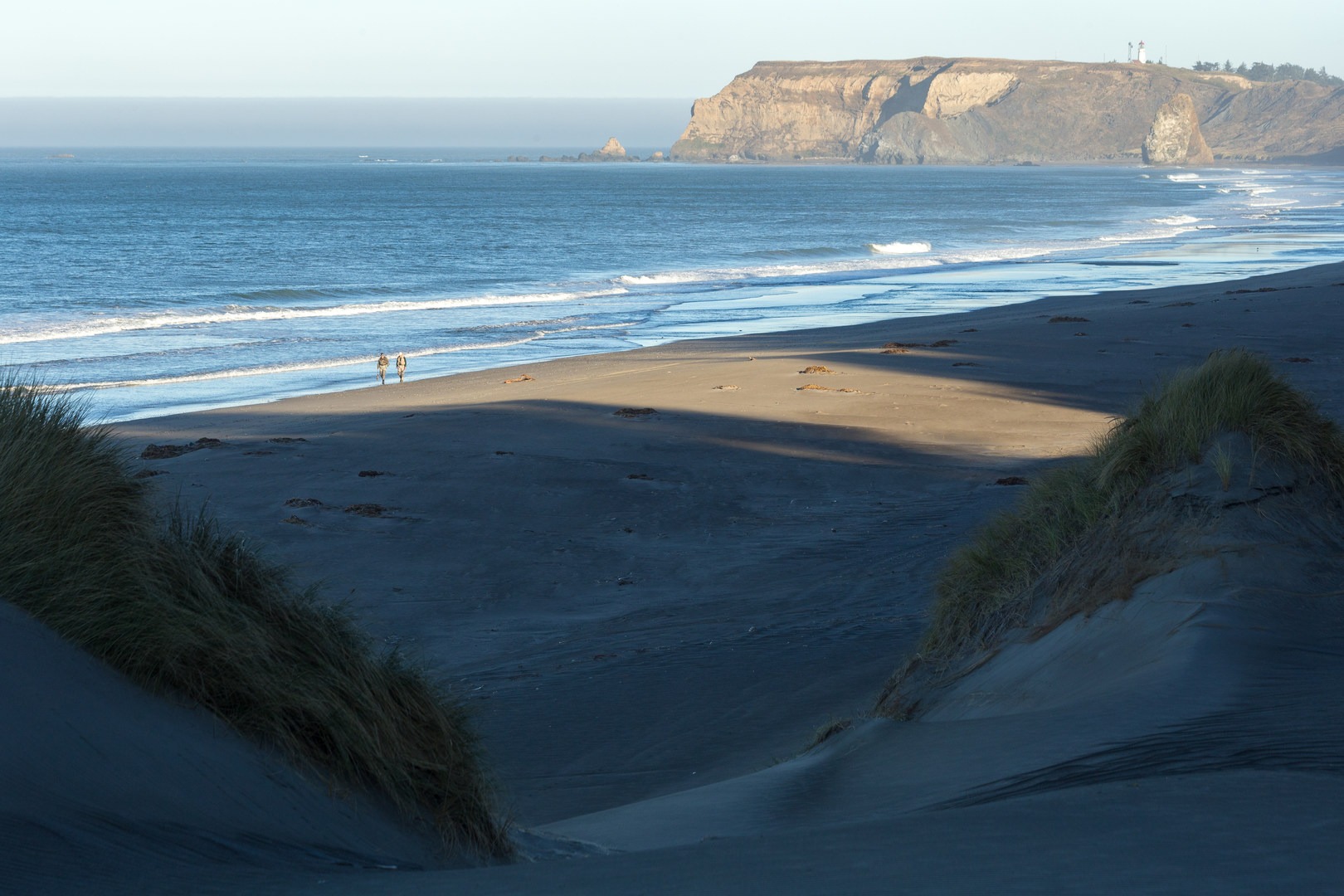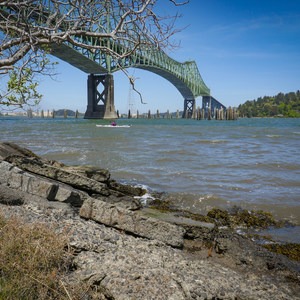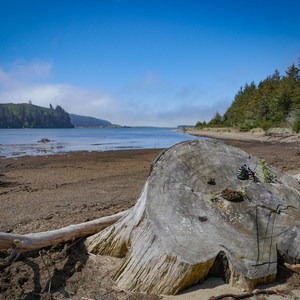Section 8 of the Oregon Coast Trail begins at the Coquille River Bridge and continues 40.5 miles to Humbug Mountain State Park. This section consists primarily of beach walking with over 27 miles on sand. Five miles are walked on roads, and 8 miles are walked on trail and/or roads that are closed to vehicle traffic. The distance of actively used road that needs to be walked is only 5 miles, leaving 8 miles of walking on trail and on roads that are closed to vehicle traffic. Section 8 can be arduous at times, especially after walking long stretches through soft sand, but the views, wildlife, coastal towns, and limited road travel make it a great representation of the Oregon coast.
Tips for hiking the Oregon Coast Trail
The Oregon Coast Trail offers hikers an opportunity to experience the beauty of Oregon’s coastal landscapes and ecosystems in an intimate and continuous way, and it passes through fragile environments. Your awareness of a few additional items can enrich your overall experience on the OCT and help minimize your impact on delicate environments along the way.
- Before departing on your hike, learn the Leave No Trace Seven Principles so that you can practice them while you are out on the trail. The more that people incorporate Leave No Trace into their decisions and habits, the better the outdoor experience will be for everyone.
- Learn about Oregon’s five unique marine reserves. Marine reserves are areas that have been set aside for study, research, and conservation; it is illegal to remove any marine life from a marine reserve, and they are also protected from any development. Marine protected areas, which are often adjacent to reserves, allow some fishing and development. Marine reserves are wonderful areas to observe wildlife and take in Oregon’s beautiful coastal scenery. Fortunately, Oregon’s marine reserves couldn’t be more accessible than when hiking the OCT. From north to south they include:
- The islands and sea stacks along the coast are protected as part of Oregon Islands National Wildlife Refuge. They provide crucial nesting habitat for seabirds and pupping/resting sites for seals and sea lions. All seabirds and marine mammals are protected by federal law and are sensitive to human disturbance. For this reason, all islands and sea stacks are closed to public access year round.
- Portions of the trail meet the ocean's waterline and may only be passable at low tide. Excercise caution and safe judgement; wait for appropriate tidal conditions in these areas, and always watch for sneaker waves.
- Pay special attention to areas signed and posted as snowy plover habitat. A handful of Oregon’s beaches and estuaries provides critical habitat for the western snowy plover, a species that the U.S. Fish and Wildlife Service listed as threatened in 1993. The breeding season for the western snowy plover is from March 15 to September 15, and during this time it is imperative to avoid potential nesting locations in dry sand beach areas. Dogs, kites, bikes, and vehicles are all prohibited from March 15 to September 15, and walking is only allowed on hard-packed wet sand. Please do your part to help this threatened species survive by complying with posted restrictions and completely avoiding closed areas. There are designated snowy plover areas from Fort Stevens to Floras Lake, and hikers should be aware of their locations. To learn more, be sure to check out these snowy plover resources:
- The Oregon coast is generally a very dog friendly location, and dogs are allowed on most beaches, state parks (when on a leash) and other coastal public lands. However, there are specific times and locations when dogs are not permitted in certain areas, such as beaches and estuaries identified as snowy plover habitat during nesting season. Please pay attention to posted signage and respect times and areas where dogs are prohibited.
- For those interested in hiking the OCT in sections, or even just accessing the trail for day hikes, take note that recreation fees and passes are required at several federal recreation sites. If you will be parking at one of the state or federal fee area recreation sites, make sure to pick up the applicable recreation pass such as an Oregon Coast Pacific Passport.
Coquille River to the New River
After crossing the Coquille River and taking in the abundance of birds and decaying wooden structures, the route continues toward Bandon along Riverside Drive. After 1.5 miles on this empty, tree-lined road you will have some experience with Bandon's quirkiness. Several houses have odd decorations and driftwood art adorning their front lawns. Take a few seconds to peek into Bandon Marsh National Wildlife Refuge and catch a glimpse of several species of migrating birds walking the mudflats, including the long-billed curlew, western sandpiper, and the semipalmated plover.
When the short time on Riverside Drive has run its course, the route turns into a unique coastal town stroll. On 1st Street you will pass Bandon Harbor and several quaint crab shacks and coffee and tourist shops. You may also notice many wooden carvings of otters, sea turtles, and other sea life spread alongside the road. A giant rainbow goldfish statue can even be spotted. Perhaps the most unique structures are the human figures made of rebar going about life as normal. One is mowing its lawn in a tie-dyed shirt, while others are riding bicycles along the sidewalk. The attention to detail in these figures makes them all the more enjoyable.
After passing the rebar humans and a decommissioned U.S. Coast Guard Station, the official route winds past a few interesting houses and eventually along the Coquille River, where the Coquille River Lighthouse can be seen on the north shore. Before you know it you’ll be on the beach at Bandon South Jetty Park, which marks the beginning of a 16.5-mile stretch of beach, the longest until the California border.
The first 3 miles of beach is dotted with sea stacks, masses of kelp, and friendly day use visitors. Small tide pools can be found among some of the rocks at low tides where many anemones, muscles, and barnacles live. The cliffside here is developed with private homes and hotels that overlook the beach. Approximately 3.5 miles in from the jetty, the cliffside development is replaced with small, grassy dunes and a line of trees as you enter Bandon State Natural Area. You will cross the New River soon after entering the natural area, and this should only be done at low tide, especially in early summer.
Unlike some areas of the Oregon coast, nearly all of this beach is restricted to absolutely no camping in order to protect the threatened western snowy plover. Please see the Tips section above for information on how to proceed through this sensitive habitat. The only camping area between Bandon South Jetty Park and Floras Lake is at a BLM primitive campsite approximately 11.5 miles south of Bandon South Jetty Park. This campsite is marked by a tall wooden pole protruding from the grassy hillside emblazoned with the word “INFORMATION.” As the name suggests, the site is primitive with no facilities and only a small area to pitch tents. There is, however, access to the New River where fresh water can be obtained.
Floras Lake State Natural Area to Humbug Mountain State Park

After spending a night at the primitive campsite there are still 5 miles of beach to hike before reaching Floras Lake State Natural Area. This stretch of beach is loaded with agates that can be found quite easily in the patches of pebbles. The downside is that the beach is steep and soft in most places, making the walk tiresome. But Floras Lake awaits, and it is a prime location for windsurfing because of the high offshore winds that blow across the lake.
There are very few reliable water sources between Floras Lake and Sixes River, so be sure to stock up at Floras Lake. After climbing the hillside to view the lake and collect water, continue on the beach until you spot the OCT sign off to the east just before the tall sandstone cliffs begin.
The trail through Floras Lake State Park spends all of its time meandering through Sitka spruce, alder, and shore pine; ferns are also quite abundant here. The trail crosses multiple seasonal streams along sturdy wooden footbridges and occasionally provides views of the ocean from high up on the cliffside. After several miles of hiking through this dense forest you will emerge at Blacklock Point, where Cape Blanco State Park, many sea stacks, and the beach stand before you. A sharp turn from the main trail drops down to the beach below Blacklock Point. The crossing of the Sixes River will be a little over a mile along this beach past some massive trees that have been washed up onto the beach. Wait until low tide when it is safe to ford the river. Continue along the beach, admiring the offshore sea stacks until you walk into Cape Blanco State Park.
As of this writing, there was no trail marker indicating where to climb the hillside to Cape Blanco. The best indication of where to walk is to watch the lighthouse. The moment the red tip of the lighthouse disappears behind the looming cliff, turn east and look for a trail heading up and over the Cape Blanco headland. For $5 per night per person, a backpacker can stay in the hiker and biker camp and utilize the bathrooms, showers, and picnic tables at Cape Blanco State Park Campground. From here the trail descends to the beach, where large dunes line the forested cliffside. Cross Elk River at low tide and continue through the forest, which becomes spotty and is occasionally dotted by houses. There is no OCT sign indicating the location of Tseriadun State Recreation Site; instead, follow the neon yellow “161” emergency sign after Garrison Lake. You made it to Port Orford!
Port Orford gives off a quintessential Oregon coastal town vibe. Art, quirky restaurants, and bizarre house decorations abound. If you’ve ever traveled south on Highway 101 through this area, you may remember seeing “OCEAN VIEW” with an arrow painted on the road and pointing up a hill. Instead of following the intriguing invitation for a view, continue down to Battle Rock Park and onto the beach once again.
The beach stretches 2 miles before reaching the end at Rocky Point. At low tide, you can pass through the rocks and avoid highway walking. If this isn't possible, look for a trail up to Highway 101; if you can't find it, the best location to ascend is at the culvert draining onto the beach. Large, sturdy rock and a relatively gradual incline make this the least dangerous path to reach the highway.
After a short distance, the highway ends across from the Humbug Mountain State Park sign. On the east side of Highway 101 is the Old Highway 101 and the correct route into the state park. Motor vehicles are not allowed on this road, making it a peaceful walk through the forest. As the road descends, ferns and blackberries take over the roadside. Hand painted rocks indicate the species of fern they sit next to, including deer fern, sword fern, leather fern, coastal wood fern, giant chain fern, lady fern, and golden back fern.
When Old Highway 101 reaches the Humbug Mountain State Park road, do not follow the weathered OCT signs back into the forest. This section of the OCT is very overgrown and blocked by several large tree falls, blackberry bushes, and hundreds of large spiders and their webs. Instead, walk south along the road to Highway 101 where Section 9 begins.
Risks of hiking road sections
Although officially designated as a trail over 40 years ago, the OCT is an ongoing project and not yet a single continuous hiking trail. Gaps in the trail, usually caused by rivers, bays, or rocky headlands, require hikers to walk along busy roads (often U.S. Highway 101) that are not designed for pedestrian use. Oregon Parks and Recreation Department and other public and nonprofit agencies, including local cities and counties along the Oregon coast, are working to eliminate these breaks by establishing trails to connect trail segments and beaches.
In 2016, the Oregon legislature enacted legislation requiring OPRD to complete an action plan that will identify steps needed to complete the trail. This planning effort will identify key stakeholders and document the current status of trail completion, evaluate and assess alternatives for completing trail segments, and seek funding to complete new trail sections.
Until the trail is completed, OCT hikers will have to decide whether they choose to walk along the shoulder of the highway that is, in fact, currently an official part of the trail. It is important for OCT hikers to understand the risks of walking along the highway portions of the OCT. The most prevalent dangers are being hit by a vehicle or being struck by debris kicked up by or flying out of a passing vehicle. In addition, some highway sections along the Oregon Coast Trail are longer and more difficult than others. These highway sections are detailed in each section's guide.
Public safety is of the highest concern at Outdoor Project, and we do not condone walking along roads without a designated pedestrian path. We support utilizing other modes of transportation to connect the trail and beach sections such as public transportation, private shuttle or taxi, biking, ferry, or completing the Oregon Coast Trail in hiking sections to avoid the highway altogether. Two great resources for finding alternative transportation are Google Transit (Google.com/transit), Visit The Oregon Coast (visittheoregoncoast.com/transportation/), and an internet search for taxis or other transportation alternatives in the town nearest to the trail break. There are also ferry services available to cross the Nehalem River, Tillamook Bay and the Umpqua River, and these will greatly reduce the amount of highway miles one must walk. Note that ferry boats do run on a regular schedule and must be reserved in advance. More information on each of these ferries is found in Section 2 and Section 6.
This guide provides information needed for hikers who do choose to walk the trail in its entirety, including those portions along the highway. We urge those hikers to exercise caution to ensure a safe and enjoyable hike on the OCT.
For further information on the Oregon Coast Trail, be sure to check out these articles:
- Oregon Coast Trail Overview
- Oregon Coast Trail Section 1: Fort Stevens State Park to Oswald West State Park
- Oregon Coast Trail Section 2: Oswald West State Park to Tillamook River Bridge
- Oregon Coast Trail Section 3: Tillamook River Bridge to Bob Straub State Park
- Oregon Coast Trail Section 4: Pacific City to Otter Rock
- Oregon Coast Trail Section 5: Otter Rock to Heceta Head
- Oregon Coast Trail Section 6: Heceta Head to North Bend
- Oregon Coast Trail Section 7: North Bend to Bandon
- Oregon Coast Trail Section 9: Humbug Mountain State Park to Pistol River
- Oregon Coast Trail Section 10: Pistol River to California
Logistics + Planning
Current Weather: Powered by Dark Sky







Preferable season(s)
Congestion
Parking Pass
Open Year-round
Days
Pros
Cons
Trailhead Elevation
Highest point
Features
Typically multi-day
Permit required
A profound concept originally envisioned by governor Oswald West, in 1967 the Oregon legislature ultimately realized his vision of making the entire Oregon Coast forever open to the public in a piece of landmark legislation titled the Oregon Beach Bill, officially making all 363 miles public land. "The People's Coast" is truly a one-of-a-kind coastline, a unique blend of mountains and rocky stacks, towering old growth forests, marine sanctuaries, tide pools and kelp forests, charming towns, historic fishing communities, world-class golfing, breweries, and simply jaw-dropping scenic beaches. We encourage you to plan your next trip at visittheoregoncoast.com or by calling (541) 574-2679.


















Comments
Sign In and share them.